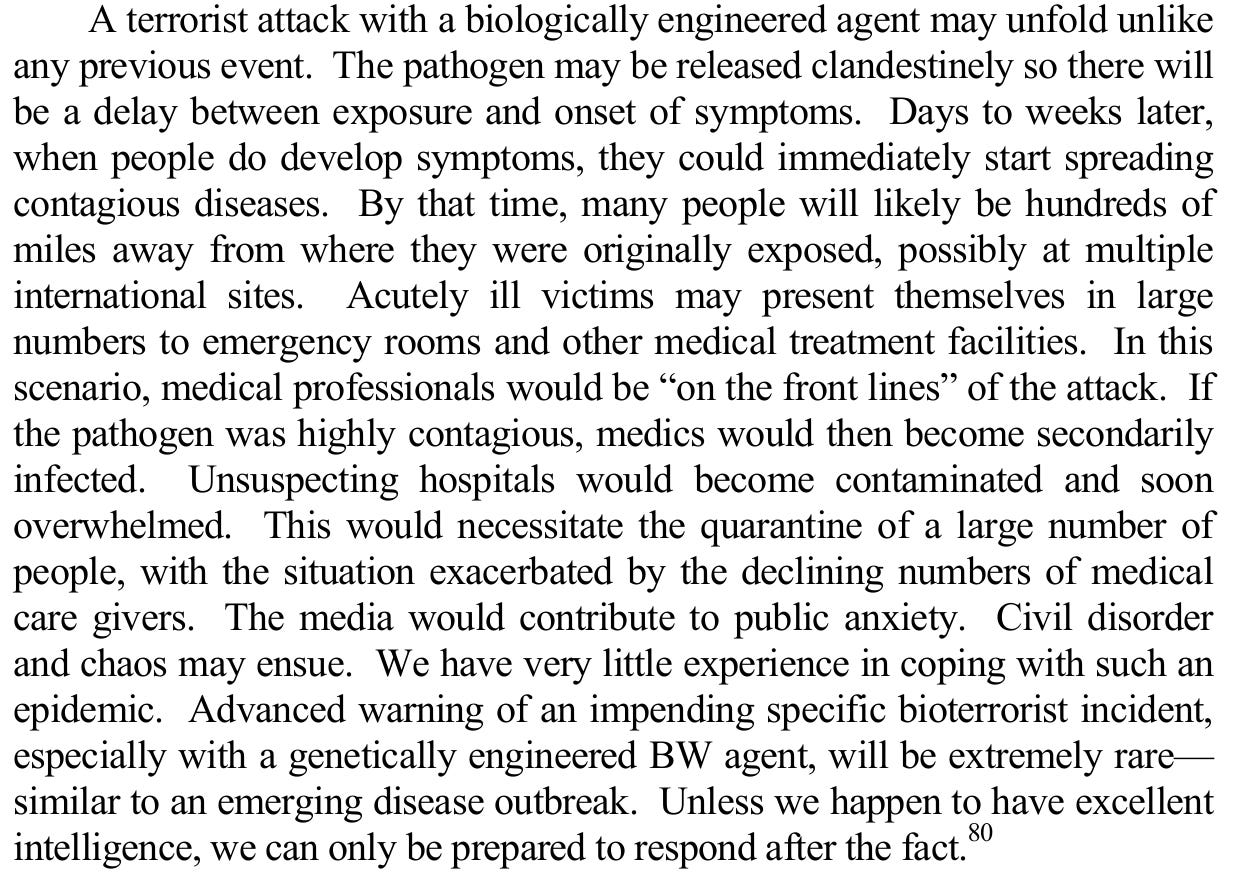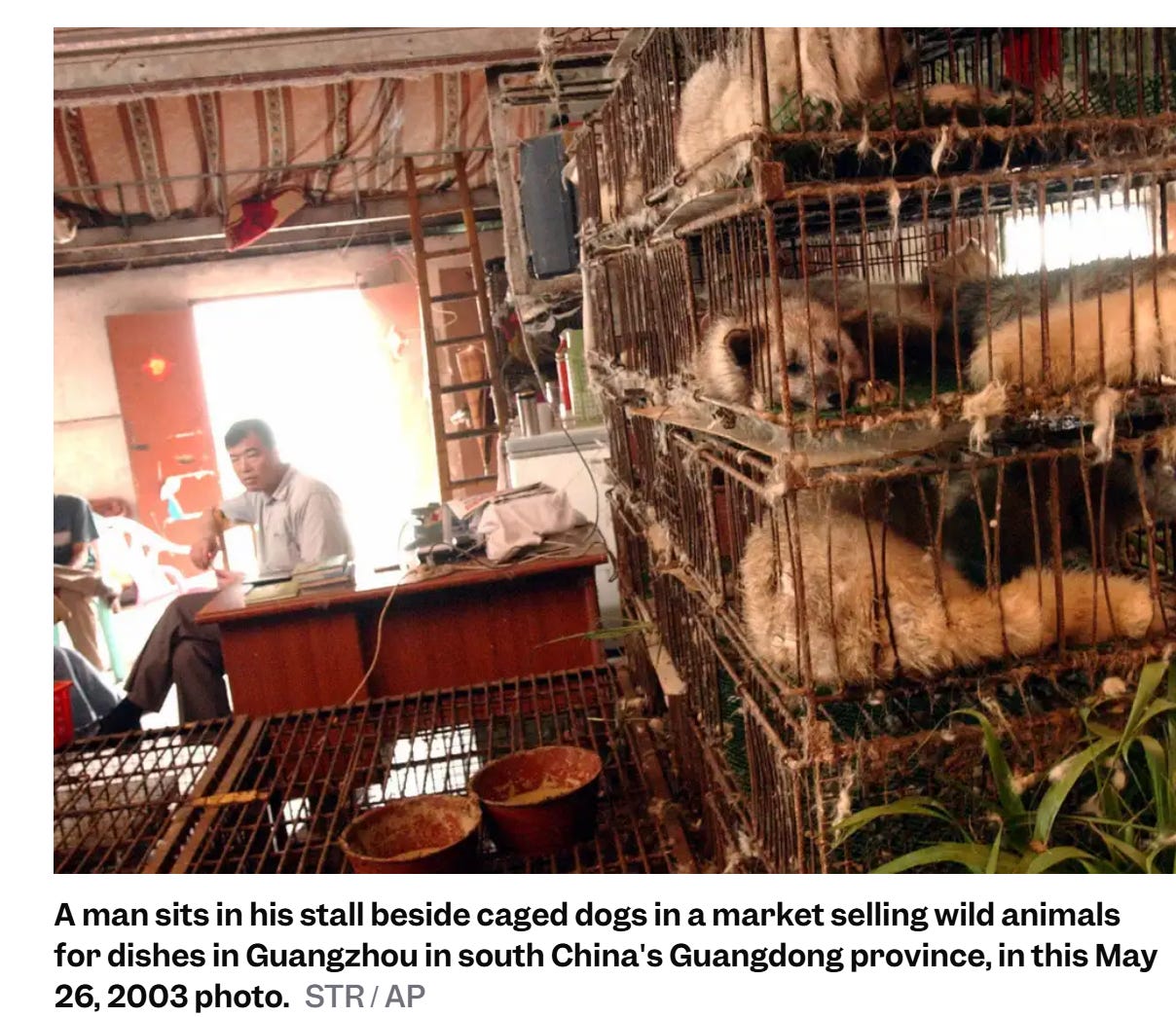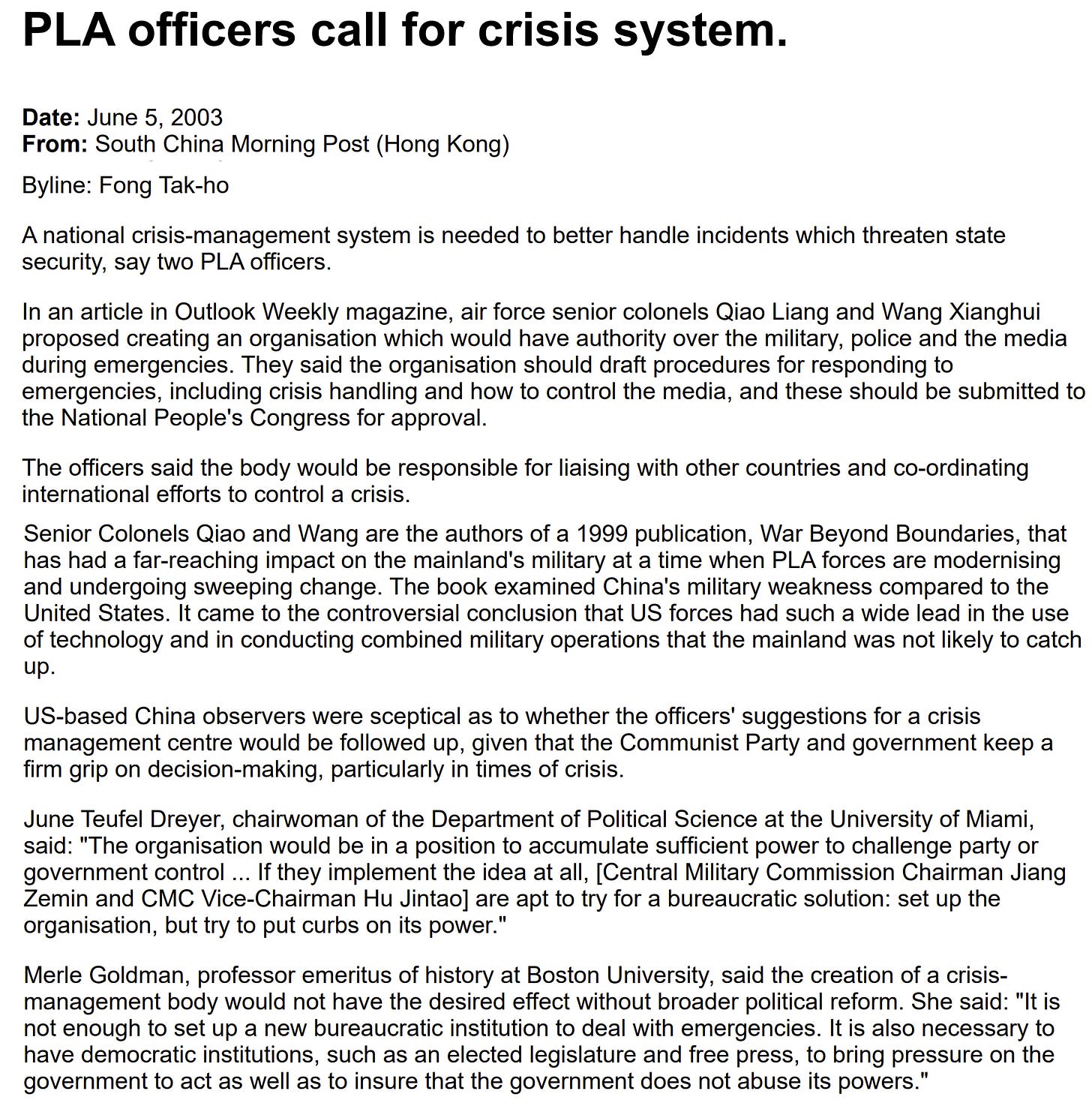Did the US collude with China to conceal the origin of SARS?
The SARS epidemic played out exactly as a bioterrorist attack with a genetically engineered pathogen had been predicted to. Why was the possibility ignored in Washington?
In recent posts I’ve described the bizarre epidemiology of SARS, and the perfunctory investigation, led by Hong Kong health authorities, which never considered the possibility of terrorism. This was perhaps to be expected given Hong Kong’s knotty relationship with the mainland. But should the US, with a rapidly expanding biodefense industry and global leadership in combating terrorism have played an active role in investigations?
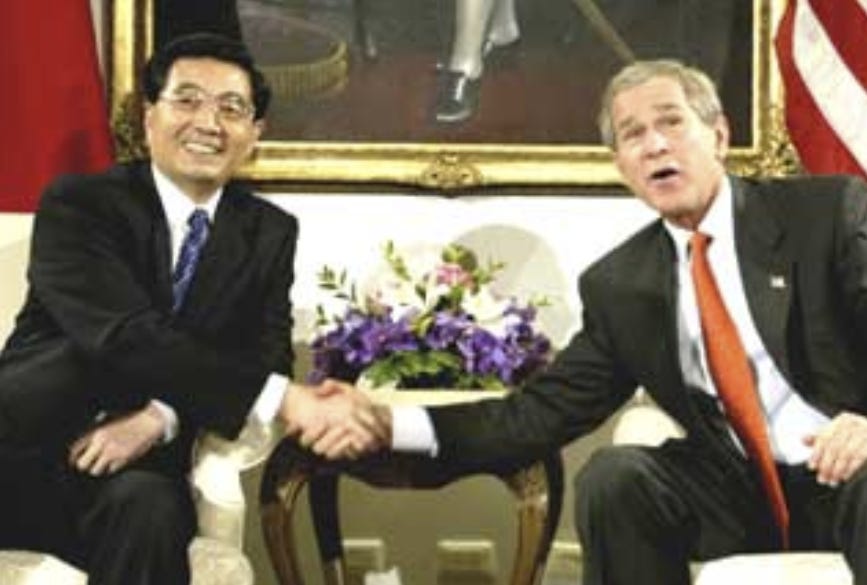
Just months before SARS broke out, USAF Colonel Michael Ainscough warned of the threat of “next generation bioweapons” that have been enhanced by new genetic engineering techniques. He envisaged how a bioterrorist attack might play out.
His depiction is uncannily similar to the way the SARS epidemic unfolded just a few months later - to a degree it could have been inspired by his work. SARS is, to this day, believed to transmit only in close contact situations, via large respiratory droplets or fomites but there are a handful of “super-spreader” incidents in which SARS can only have transmitted by aerosol. These might more readily be explained as terrorism.
The early spread in Guangdong in which 150 million bulk text messages were sent over 3 days, warning of a mysterious disease causing many deaths and infecting staff in hospitals. Online rumors told of an incident at Guangzhou’s World Trade Center in which hundreds of people were infected at once causing 30 deaths.
In the 3 days Guangdong was being terrorized by a largely phantom epidemic, Hong Kong police investigated leaflets being distributed near the Kowloon mosque that declared support for Bin Laden and a “terrorist new era”.
The international outbreak had its epicenter in Room 911 of Hong Kong’s 500 room Hotel Metropole. Over twenty guests were infected on one floor - who then carried it to several other countries. But no-one, including staff, were infected anywhere else in the hotel.
On the day of the confirmation of China’s new President Hu Jintao, 24 people were infected on Flight CA112 from Hong Kong to Beijing (a 3-hour flight). Investigators later identified 35 flights on which known SARS cases had traveled and only found 5 infections resulted from all the other flights combined.
At the Amoy Gardens high-rise estate over 320 people were infected at once, in 15 separate tower blocks up to 100m apart. HK authorities blamed it on a visitor to the estate who had diarrhea - combined with faulty plumbing.
Some of these incidents not only look as though they may have been deliberate, but that the perpetrators wanted them seen to be terrorism and to have them associated with 9/11 - like the anthrax killings a year earlier. It is likely that stoking psychological terror - rather than maximizing lethality - was the main objective, echoing “Unrestricted Warfare”:
“If terrorists confined their operations to traditional approaches: bombings, kidnappings, assassinations, and hijackings, this would instill less than the maximum degree of terror. What really strikes terror into people's hearts is the melding of terrorists with new technologies that may evolve into superweapons. We already have a hint of what the future may hold. When Aum Shinrikyo discharged Sarin gas in a Tokyo subway, the casualties from the poison accounted for just a small portion of the terror. This event put people on notice that modern biochemical technology had forged a lethal weapon for terrorists whose ambition was the mass destruction of humanity.”
The speed with which the narrative of SARS natural origin via animals gained acceptance is baffling. At the time there was very little evidence available. Nonetheless stories in two influential newspapers of record in late April made it appear the case was all but settled. The Times on 26th April:
They were outdone the next day by the New York Times’ graphic depictions of wildlife markets.
What was the basis of this confidence in an animal origin? What were the preliminary studies they referred to?
At this time there was no evidence of an animal host of SARS. The first SARS coronavirus sequence was made public on April 16th, by a Canadian group, followed in quick succession by HKU. At a press conference, HKU’s J.S. Malik Peiris asserted there was no chance the novel virus was man-made: "The whole genome is new" he said "Nature has been the terrorist throwing up this virus.". While it was true at this time no-one had published a closely related virus, it isn’t possible to discount that someone had discovered one - and not disclosed it. This same false reasoning has recently been applied to the origin of SARS-CoV-2. It should be obvious that one reason for not announcing such a discovery is if it was intended to be used for terrorism or warfare. But this argument has been off-limits as any suggestion of bioterrorism has become taboo.
The next day the PLA’s AMMS published a SARS sequence from a patient which had an unusual genetic feature: an extra 29 nucleotides. A paper describing the sequence claimed the patient was linked to one of the earliest cases in Guangdong. They speculated this variant had only recently transmitted from an animal, the extra nucleotides hindered replication in humans, so had been deleted in later cases. This speculation was eventually shown to be false (in 2018 by a German team led by Christian Drosten).
The only data available at the time that suggested an animal origin came from Guangdong CDC, but it wasn’t especially compelling. Their data showed that of the earliest 23 cases they had identified, 9 were in people who were in food handling jobs. Even if we consider Guangdong CDC trustworthy, this is a tenuous connection. The official record has it that the first SARS case was in Foshan on 16th November 2002 (the day after Hu Jintao’s election as CCP General-Secretary). But this was 5 months before tests would become available, and the pathogen was still unknown. Diagnosis was on the basis of symptoms, sometimes supplemented with radiography, but it is difficult to distinguish SARS from other respiratory illnesses objectively. A doctor alert to its peculiarities might be able to diagnose it, but the earliest SARS cases were diagnosed retrospectively, scored on a spreadsheet.
Guangdong at the time was a province of 85 million people. Over half a million people die in a population that size each year, perhaps 50,000 of them from respiratory diseases. To add to this Guangdong was experiencing an unusual “cold wave”, resulting in higher than normal incidence of pneumonia. For perspective there were only around 1500 SARS cases, and 57 deaths recorded through the entire epidemic in Guangdong. As public health events go, SARS might even have been viewed as trivial - if it wasn’t for that handful of unexplained super-spreader incidents.
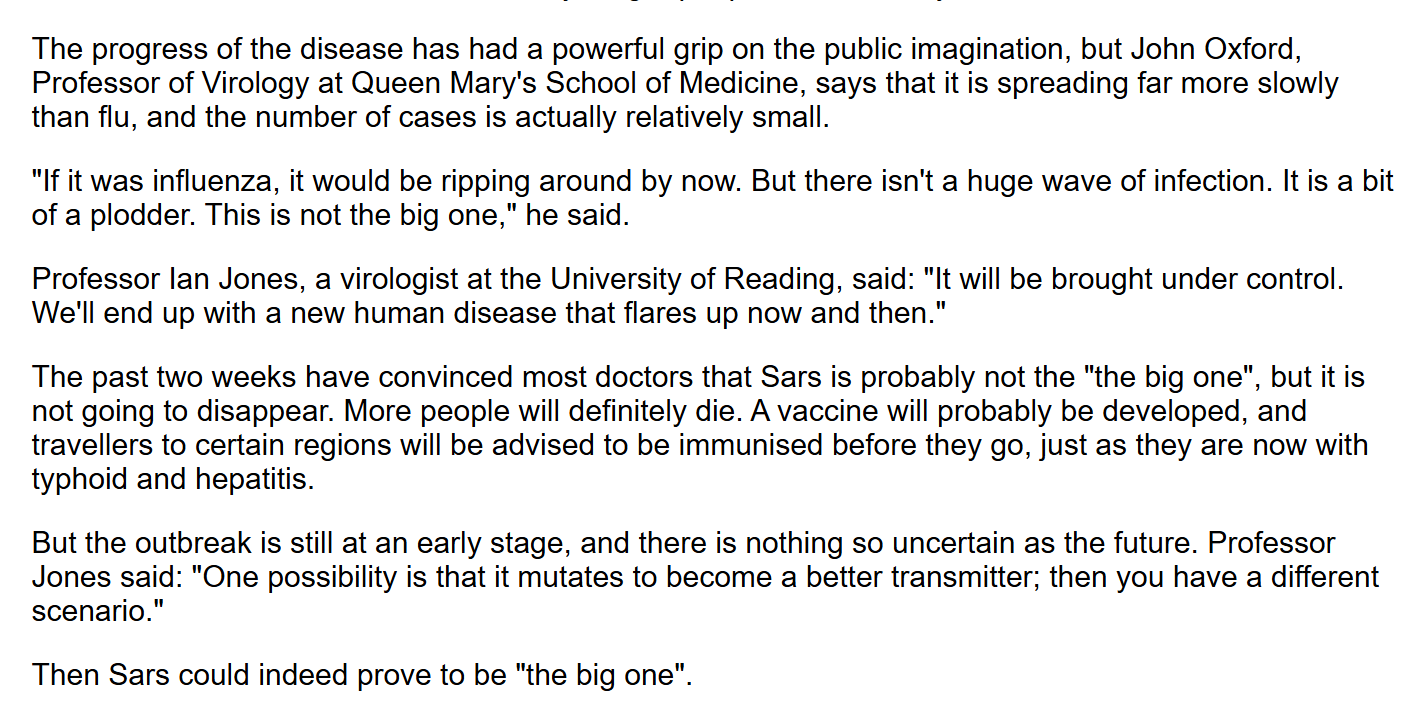
But a few weeks later, AMMS and the over-eager press appeared to have been vindicated. On 23rd May, the HKU scientists and Shenzhen CDC announced they had sequenced a virus very close to SARS in samples taken from 6 civet cats and a raccoon dog being sold alive for food in a Shenzhen market. Miraculously these had the same 29-nucleotide insert matching the early Guangdong case AMMS had sequenced. It seemed the missing link to an animal host had already been confirmed.
The WHO announced this at a press conference, and it seems to have been nearly universally accepted by the general public that the case was closed. Yet even today, scientists can’t explain how it evolved and how it traveled to Guangdong. Few now believe civets were the source or a reservoir. No human or civet infections have been reported in 20 years. It is certainly related to bat coronaviruses but has never been found in a bat or proven capable of infecting one. While many details remain unknown or disputed, even most scientists accept SARS is natural. But on what evidence was an artificial origin ruled out?
As with SARS-CoV-2, There was never any investigation into the possibility of an artificial origin. US CDC Director Julie Gerberding’s comment that “we are keeping an open mind”, was echoed by Anthony Fauci during the Covid-19 pandemic.
Some of the haste to dismiss the possibility might be put down to terrorism fatigue. Prosecuting the terrorist acts of a few had already led to the invasion of Iraq and Afghanistan and the harassment of US scientists by the FBI. No-one wanted a confrontation with China, there was no military option that wouldn’t result in immense bloodshed. The Bush administration hoped China would become an ally in a global campaign to tame or effect regime change in “rogue states” - particularly North Korea. In any case, the US was relatively unscathed by SARS, there was no howling for vengeance from its few victims.
The cognitive dissonance is palpable in the biodefense and foreign relations communities. In early May, China and public health scholar Yanzhong Huang wrote a report on SARS for the Chemical and Biological Arms Control Institute (CBACI). The foreword by CBACI President Michael Moodie ruled out the possibility in one terse sentence. There are no citations or justification offered.
“One of the questions about SARS asked very early during the outbreak was: Was it deliberate? This time the answer was no. But the fact that the question is inevitably asked when an unusual outbreak of disease erupts anywhere around the globe reflects the unfortunate reality of today’s world.”
Huang skirts the issue - that SARS looks a lot like bioterrorism - by addressing it as a “weak proxy”, a useful learning exercise for the real thing.
“The SARS outbreak also yields some useful lessons for biosecurity by serving as a “weak proxy” for biological warfare or bioterrorism attacks…a global response is needed to address the bioterrorist threat because terrorists would likely introduce a pathogen in many locations simultaneously, making it more likely to spread…In that respect, a Hong Kong comedian was right when he commented that the worldwide SARS outbreak might be the first coordinated global exercise in the fight against biological warfare.”
Huang was invited to a Congressional roundtable to discuss SARS. He and the other speakers unanimously urged the US to engage more closely with China in the areas of public health and biotechnology. Some proposed the US should respect China’s “sensitivities” and refrain from too harshly criticizing the regime over its agreed deficiencies (lack of transparency, misinformation, bureaucratic dysfunction). No-one refers to a suspicion of bioterrorism.
But Huang again hints at the more general concerns about China’s interest in bioweapons.
“China is listed by the U.S. government as one of the countries of greatest concern regarding biological weapons proliferation. This led former U.S. President Bill Clinton to conclude: “The weakness of great nations can pose as big a challenge to America as their strengths.” While the rise of China as a belligerent superpower is not in the interest of the international community, the collapse of China into a “messy state” or “failed state” can be equally dangerous, given the sheer size and strategic importance of this country.”
Huang provides some insight into the factional wranglings among the senior leadership of the CCP and the PLA. Hu Jintao became CCP Secretary-General in November 2002, and President of China on March 15th, 2003, but he didn’t automatically assume command of the PLA. His predecessor Jiang Zemin retained the position of Chairman of the Central Military Commission until he voluntarily resigned in September, 2004.
So when, on 17th April, Hu Jintao ordered a new approach to SARS - demanding full transparency of the situation, and aggressive control measures - the PLA did not immediately comply. They awaited the command from Jiang Zemin.
“The military not only refused to divulge important statistics to the Ministry of Health on SARS cases, but also failed to extend its support to the nationwide campaign until April 28. Jiang’s order on April 28 to mobilize military health personnel is significant in that it suggests the lack of authority of Wen Jiabao and even Hu Jintao over the military. With the rise of the military as an independent force in Chinese politics, the traditional party-state dualism seems to be increasingly replaced by a triumvirate of state, military, and party institutions.”
Richard Fisher of the Jamestown Institute was a credible proponent of a bioweapon origin. He pointed out that, despite China’s signing of the Biological Warfare Convention, and official denial of an offensive bioweapons program, there was evidence suggesting otherwise.
“China does declare that it has research facilities devoted to “defensive” biological warfare. And a possible interest in biowarfare is, at the least, demonstrated by the large number of articles in PLA military medical journals on viruses like Equine Encephalitis, plague, tularemia, and cholera. In addition, Alibek [Soviet bioweapons expert who defected to the US] refers to Russian reports suggesting that Russian biowarfare specialists may be trying to sell their knowledge to China.”
Fisher urged caution, and to await the outcome of scientific investigations.
“Although it might be tempting to give China the benefit of the doubt, that could prove dangerous. China’s long record of failing to honor arms control commitments justifies a skeptical attitude toward its willingness to meet commitments in the area of biological warfare. The Chinese leadership’s paranoia, which led it to suppress reporting of and information about SARS starting last November, justly raises questions as to whether China may also be hiding a military-related disaster. Indeed, many Chinese harbored exactly this suspicion… As of late April, it remains impossible to conclude from the reported scientific research that the SARS virus is related to a man-made, or indeed, a military program. The key remaining question in this context involves the precise animal origin of this virus. If that animal source cannot be determined, then Kolesnikov’s suggestion that it is man-made deserves investigation.”
Over two decades later that animal source remains elusive, the evolutionary trail is incomplete and disputed, the scientific investigation - led by WIV and AMMS - is compromised by fraud. But this not how the public or the Washington commentariat perceives it. For most, the matter was settled in late April 2003.
Why there was such haste to declare SARS natural? When George Bush spoke to Hu Jintao on April 25th, he was grateful to Hu for having brought North Korea to the table for nuclear disarmament talks. That had been another looming confrontation for which there was little appetite. Bush offered Hu “any possible support and assistance” in dealing with SARS. The US understood the tension between Hu and Jiang Zemin’s faction which still controlled the PLA. Jiang was a close ally of General Chi Haotian - who officially retired in March 2003, but remains a powerful influence over the PLA to this day. Jiang and Chi were together responsible for the brutal military response at and after Tiananmen Square. Chi is reputed to be a proponent of biowarfare, an aggressive ethno-nationalist and expansionist. The day after the Bush-Hu call, articles started appearing in newspapers-of-record promoting (without evidence) a natural origin of SARS. Three days later Jiang appeared to back down from his stand-off with Hu over SARS - eventually resigning his military leadership quietly.
Coincidence?
My speculation is that a deal was made. The US would overlook the terrorism - assessing it as the plot of an extremist PLA faction, not the new civilian regime. They would increase their support for the civilian Chinese state under Hu. The hardliners were offered forbearance for past misdeeds in exchange for a smooth transfer of power.
All’s well that ends well. By early June, Hank Paulson, CEO of Goldman Sachs (later Treasury Secretary under Bush) was in Beijing touting for business, singing the praises of China’s leadership, encouraging the people in their heroic struggle against SARS (by then almost won). Sino-US relations seemed stronger than ever. The US and other Western nations committed to help China hunt for novel pathogens, to fund and train their scientists, and to help them construct new biosecurity labs - such as the Wuhan BSL-4. The search for the origin of SARS continued for many years led by the Wuhan Insitute of Virology and AMMS ,with the assistance of international collaborators: Institut Pasteur, CSIRO and EcoHealth Alliance. The terrorism potential of SARS was immediately recognized so, despite its disappearance from the world, research into it continued with that as justification.
The “hardline faction” in the CCP never truly relinquished power. Hu Jintao himself can hardly be considered moderate, having been promoted because of the brutal repression he oversaw in Tibet. The aged Chi Haotian still lurks in the background and seems to have been involved in some way in the recent purges of senior PLA officers. The authors of “Unrestricted Warfare” published a call for a national crisis-management system that would have powers to overrule government authorities, co-ordinate international efforts, and control the media. A blueprint for the recent WHO treaty?


